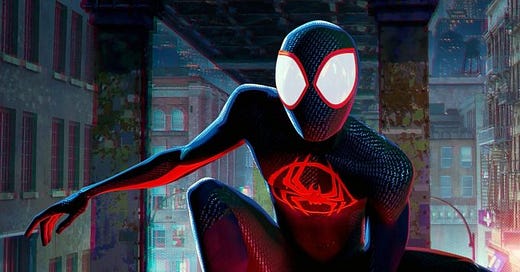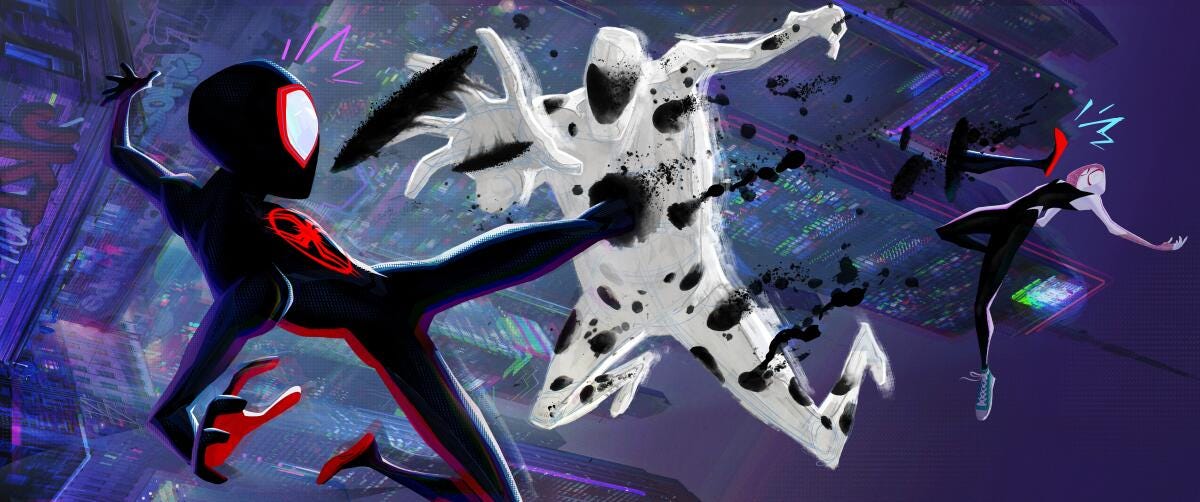There has been one (1) occasion since I started this newsletter that I went into a movie knowing what I was going to write about.
You see, I had found myself watching a lot of sequels and wondering why some were tremendous (Toy Story 3), while others fell flat (Finding Dory). I just needed my “main course”—the paragon of sequels from which I could derive some set of rules or lessons.
Of course, I could go to the classics. The Godfather Part II, for example. Or The Empire Strikes Back. But I wanted to find something more modern and exciting.
And then Spiderman: Across the Spiderverse came out.
The follow-up to one of the greatest Marvel superhero animated movies of all time, led by the creative powerhouse that is the partnership of Phil Lord and Christopher Miller, was sure to earn an instant spot on the Mount Rushmore of amazing sequels.
I walked into the movie theater knowing exactly what I was going to write about.
And I watched in gleeful horror as one of the best movies of the year flouted every single rule I was counting on it to follow.
Let’s act like we’re script reviewers for a production company. We’ve been handed a new script called Spiderman: Across the Spiderverse and it’s our job to recommend it (or not) to our boss.
Does the film establish a clear protagonist?
This is a pretty basic tenet of screenwriting. If you want your audience to empathize with a character, get them on screen as fast possible.
So then why does Across the Spiderverse open with ten minutes detailing Gwen’s troubled relationship with her father?
There I was, still trying to fit the film into my newsletter idea and sure that this meant the sequel was going to make Gwen the protagonist.
Interesting, I thought to myself. This will pair nicely with my discussion of Finding Dory, in which I argued that writing a sequel about a side character can be challenging because—
And then Miles Morales swoops into frame and takes his story back.
Turns out, Miles is the protagonist.
Hm. I thought. Okay…
Does this film follow a traditional 3-act structure?
Structure is the blueprint of a movie. It’s the first thing you’re taught in film school (or at least, the first thing I was taught in my screenwriting classes) because it’s easy to teach, easy to learn, and generally helps your movie stay on track.
A three act film follows this arc:
Act I: the protagonist starts in the “old world,” where are they are used to some way of life
Act II: the protagonist makes some decision that thrusts them into the “new world,” where everything they thought they knew is wrong and they are forced to learn/grow/change
Act III: the protagonist returns to the “old world,” having changed
This is how I mentally demarcated the acts of the film as I watched it:
Miles starts off as the friendly neighborhood Spiderman, struggling to balance school life and superhero life. He encounters a small-time bad guy named Spot.
Miles chases Spot across dimensions, witnessing as Spot grows more and more powerful. Eventually, Miles is captured by other Spiderpeople, but escapes to go confront Spot once and for all.
…
Needless to say, I was a little surprised when the credits rolled before the third act even began.
Turns out, this movie was originally titled Across the Spiderverse: Part I. However, they dropped the “Part I” when they changed the name the third installment in the series from Across the Spiderverse: Part II to Beyond the Spiderverse.
I, tragically unaware of this backstory, was left hanging, wondering where the heck the end of the movie was.
Does the protagonist have a clear arc?
I’ve posited before the protagonist’s arc from one perspective to another is the entire point of telling a story. So this one’s a biggie. Rephrased: does Miles learn a lesson?
Well, he starts off by annoying Spot, calling him a classic “villain-of-the-week” bad guy. This prompts Spot to grow bigger and more powerful, until Miles glibly apologizes and assures him that he’s a genuine threat now.
So on the outside he learned his lesson…but is this really the takeaway? I wasn’t so sure…
Does the story have a satisfying resolution?
Of course it doesn’t—it’s only Part I! The resolution will come in the next film: we’ll just have to wait until then.
Right?
That’s how I felt leaving the theater. I debated the quality of the film with my brother and my girlfriend. I made my case that it didn’t follow any of the rules or guidelines it was supposed to follow.
I pointed to its lack of resolution, the weak character arc, and its incomplete structure.
“I liked it,” I said. “I just wish it had been a standalone film instead of a Part I.”
Months passed. I shelved the sequels newsletter, since my key witness had turned out to be a dud. I moved on with my life.
And then, a couple weeks ago, I rewatched the movie.
Now, wait a second, I thought, leaning forward on the couch and setting down my Pringles. Could it be?
And it was.
Turns out, I was an idiot.
My live dissection of the movie from my comfy theater seat was skewed by my preconceived notions of superhero movies. Spot, a bad-guy-of-the-week-turned-mega-powerful-supervillain, grows stronger and stronger as the plot progresses. I knew that the final showdown between Miles and Spot would determine the fate of the Spiderverse (and multiverse in general). I was expecting that to be the film’s resolution.
But it’s not. Because this movie isn’t about defeating Spot. It’s not about saving the world. It’s not about the triumph of good over evil.
It’s about what it means to be Spiderman.
So, with that in mind, let’s do this one more time.
Does the film establish a clear protagonist?
Who cares if Gwen’s not the protagonist of the story? The opening sequence is elite for many reasons, some of which include:
Setting the vibe: Remember how the art style of the first movie blew everybody’s minds? This sequence is the animators saying “Yeah, we could stick with that style…or we could make every dimension have its own unique art style.” It’s a perfect reintroduction to the world and concepts of the Spiderverse movies.
Setting the stakes: Gwen encounters a misplaced Vulture and has to send him back to his original dimension. This gives us an idea of the state of the multiverse after the events of the first movie and suggests how the plot of this film will unfold.
Setting the characters: We don’t know it at the time, but when we meet Spiderman 2099 (aka Miguel O’Hara), we’ve been introduced to our antagonist. He’s cool, fast, strong, and…a vampire?
Setting the conflict: In this sequence we get to see Gwen living out her Spiderperson story. We’ll learn later that all Spiderpeople live similar lives and experience “canon events” that make them who they are. Thanks to this opening, we’ve already seen this concept at work.
So no, Miles Morales isn’t in the opening sequence. But it’s a visually stunning romp that serves a key purpose in laying the foundation of the story under the guise of a fun, creative action sequence.
It’s not what I expected, but my goodness does it get the job done.
Does this film follow a traditional 3-act structure?
On the first watch, I analyzed the structure based on Miles’ conflict with Spot.
I should have based it on his conflict with Miguel, the man who deems Miles an unworthy Spiderman and challenges his very existence. This is the primary conflict of this movie; that business with Spot is just setting the table for the next film.
Here’s a more accurate 3-act breakdown:
Miles starts off as the friendly neighborhood Spiderman, struggling to balance school life and superhero life.
Miles decides to follow Gwen into a new dimension, where he meets other Spiderpeople and discovers more about the Spiderverse, including the canon events that make Spiderman Spiderman.
Miles rejects the rules of the Spider Society and narrowly escapes Miguel O’Hara.
Voila! It fits!
Does the protagonist have a clear arc?
Miles reeeeeally wants to be a part of the Spider Society. The news that Gwen was invited (and not him) cuts deep. The news that there are hundreds and hundreds of Spiderpeople in the society (and still not him) cuts even deeper.
But eventually he winds up at the Society with the opportunity to join. It’s his dream come true!
Until he realizes that, according to Miguel O’Hara and the Spider Society, there is a very clear definition of what makes Spiderman Spiderman. His father will be put into mortal danger, and Miles will fail to save him. That’s a “canon event” for Spiderpeople, which means that if it doesn’t happen, they aren’t real Spiderpeople.
This is the moment of truth for Miles: does he want to be Spiderman? Or does he want to save his dad?
BOTH! He rejects this definition of Spiderpersonhood, fights his way through the Society, and escapes to his home dimension (…or does he?).
What an arc! In a film where everyone is telling Miles who he is and how he should act, he ultimately decides for himself what makes him Spiderman.
Does the story of a satisfying resolution?
Of course it does! The climax of the film, in which Miles leads the Spider Society on a chase all around Earth-928 and the Spider Society headquarters, is a high-stakes, high-energy, high-fun sequence that will have your knuckles turning white and your teeth on edge. It’s tense and suspenseful and brilliantly choreographed, with great character moments from Miles, Peter B. Parker, Gwen (not to mention a number of fun Spiderpeople cameos).
I made a mistake the first time I watched Spiderman: Across the Spiderverse. By viewing the film through an analytical lens, I entirely missed the story being told.
So why didn’t my analytical lens work on this movie?
Because it was creative. It was new. And it didn’t care about my analytical lens.
I find that it’s easy to equate the analysis of art with rules for art. Consider the following:
The Rule of Thirds in Art/Photography
Three Act Structure in Screenwriting
Perfect Cadences in Music Theory
These are three concepts that are commonly considered “rules” in their respective fields (one of them even has “Rule” in the name). Photographers will position their subjects perfectly along the gridlines present in their camera lens; screenwriters will add pages of nonsense to fill in Act II; musicians will cram an unnecessary dominant chord into their piece to force a clean resolution.
But these are not rules; rather, they are analytical tools that arose after the existence of meaningful art as a way to explain how that art was made and why it works.
Of course, there is a pedagogical value in understanding how masters of the past constructed their art. In this way, analysis can serve as an input to creation. If I hear an interesting chord in a song, it’s helpful to break it down and understand how it functions so that I can use it in my own work. But to base an entire work off of these analytical tools is foolish and unoriginal.
If your work fits perfectly into existing analytical frameworks, then you haven’t offered anything new to the world. In this way, the pursuit of perfect art creates a feedback loop that discourages innovation and rewards conformity.
In contrast, the beauty and inherent challenge of creation lies in reinventing what was done before; you learn from the past, of course, but you also build on it to make something new.
Sometimes, the result doesn’t quite work. But that’s fine, because other times, the result is Spiderman: Across the Spiderverse.








